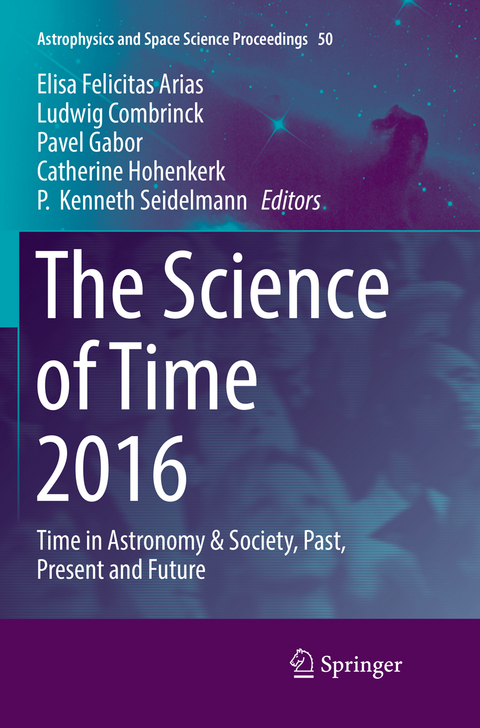
The Science of Time 2016
Springer International Publishing (Verlag)
978-3-319-86732-8 (ISBN)
In this symposium speakers took a closer look at time in astronomy, other sciences, cultures, and business as a defining element of modern civilization. The symposium aimed to set the stage for future timekeeping standards, infrastructure, and engineering best practices for astronomers and the broader society. At the same time the program was cognizant of the rich history from Harrison's chronometer to today's atomic clocks and pulsar observations. The theoreticians and engineers of time were brought together with the educators and historians of science, enriching the understanding of time among both experts and the public.
Felicitas Arias, Ph.D., is Director of the Time Department, International Bureau for Weights and Measures in Sevres near Paris.Responsible for the maintenance of Universal Coordinated Time. Ludwig Combrinck, Ph.D., is Acting Managing Director of the Hartebeesthoek Radio Astronomy Observatory (HartRAO), National Research Foundation, South Africa. His main interests are space geodesy and general relativity. Pavel Gabor, Ph.D., is Vice Director of the Vatican Observatory responsible for its observational facilities in Arizona. He is involved in the robotic upgrades of three telescopes and other astronomical instrumentation projects. As a Jesuit priest and an official of the Holy See, he also studies timekeeping, its history and symbolism. Catherine Hohenkerk, HM Nautical Almanac Office (HMNAO), UK Hydrographic Office, a long standing member of HMNAO, fellow of the Royal Institute of Navigation, Chair of the long standing IAU Division Aworking group Standards of Fundamental Astronomy (SOFA) and President of IAU Division A Commission for Fundamental Standards. P.Kenneth Seidelmann, Research Professor of Astronomy at the Universityof Virginia; former director of astrometry directorate at the U.S. Naval Observatory, Co-editor of the Explanatory Supplement to the Astronomical Almanac, Co-author of books on astrometry, time, and celestial mechanics and astrodynamics, and author of many scientific papers.
The scientific and technical uses of time and time series data.- The civil and scientific understanding of time - education andoutreach.- The history of time and timepieces, clocks and calendars.- Social, cultural, and religious uses of timing information High-precision time from sundials and the pendulum to atomic clocksand pulsars.- Impact of precise time and frequency measurement in astronomy & basic science.- Earth rotation and time Time and solar-system ephemerides.- The physics of time.
| Erscheint lt. Verlag | 14.8.2018 |
|---|---|
| Reihe/Serie | Astrophysics and Space Science Proceedings |
| Zusatzinfo | X, 394 p. 169 illus., 136 illus. in color. |
| Verlagsort | Cham |
| Sprache | englisch |
| Maße | 155 x 235 mm |
| Gewicht | 617 g |
| Themenwelt | Naturwissenschaften ► Physik / Astronomie ► Astronomie / Astrophysik |
| Schlagworte | Atomic clocks • future timekeeping standards • Harrison's chronometer • history of time • metrology proceedings • Philosophy of Time • pulsar observations • quantum theory and time • science of time • timekeeping in astronomy |
| ISBN-10 | 3-319-86732-6 / 3319867326 |
| ISBN-13 | 978-3-319-86732-8 / 9783319867328 |
| Zustand | Neuware |
| Haben Sie eine Frage zum Produkt? |
aus dem Bereich


